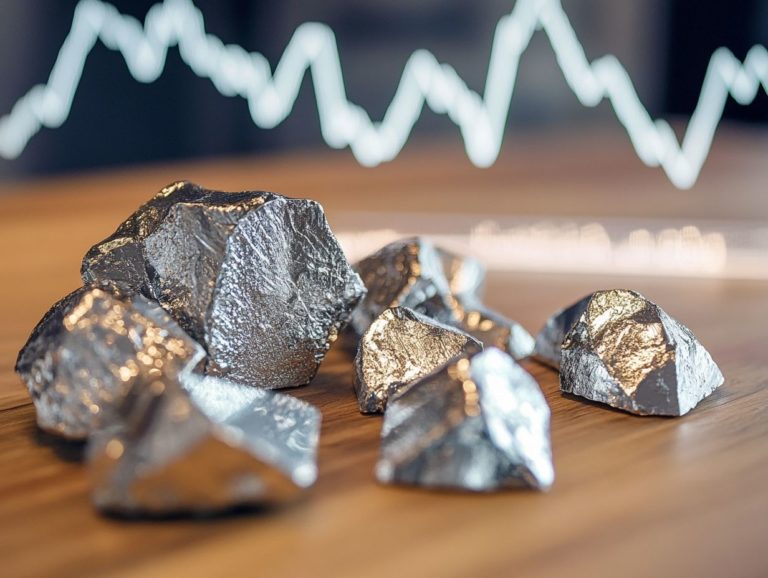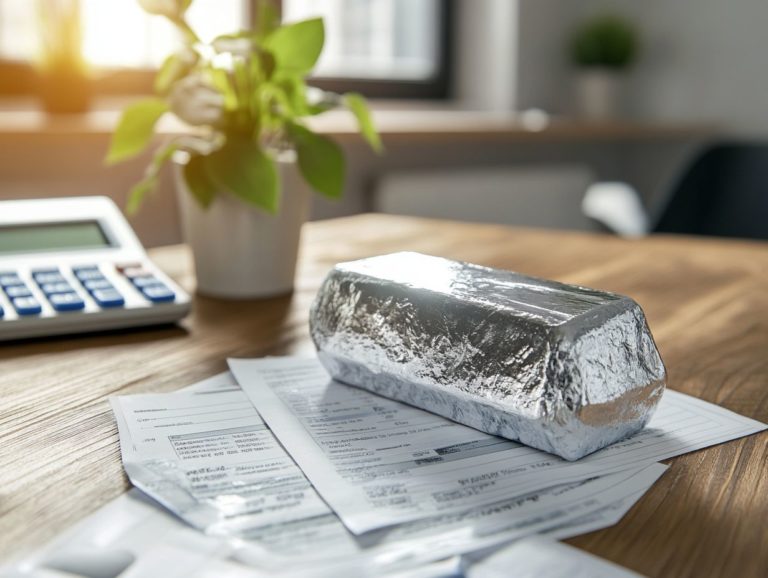Platinum and Palladium: A Comparative Investment Guide
Contents
- Understanding Platinum and Palladium
- Key Takeaways:
- Uses of Platinum and Palladium
- Investing in Platinum and Palladium
- Comparing the Performance of Platinum and Palladium
- How to Buy and Store Platinum and Palladium
- Frequently Asked Questions
- What Factors Affect the Prices of Platinum and Palladium?
- Is It Possible to Invest in Both Metals?
- What Are the Storage and Maintenance Requirements?
- Are There Any Tax Implications for Investing?
Understanding Platinum and Palladium
Platinum and palladium, often overshadowed by their more famous counterparts gold and silver, hold significant importance across various industries and in investment portfolios.
Understanding these unique precious metals is essential. Whether you re looking at their distinct industrial applications or considering them as sought-after investment assets, this article delves into the myriad uses of platinum and palladium. It compares their historical performance and highlights key factors you should consider when investing in them.
You ll also find practical guidance on how to buy and store these valuable assets. Whether you re an experienced investor or just curious about these metals, you re in for a treat!
Key Takeaways:

- Platinum and palladium are precious metals with various industrial and commercial uses.
- When considering investing in platinum and palladium, factors such as market trends, supply and demand, and pros and cons should be carefully evaluated.
- To purchase and store platinum and palladium, investors have different options and should prioritize security in their decision-making.
What are Platinum and Palladium?
Platinum and palladium are precious metals celebrated for their exceptional qualities. They can withstand high temperatures and have remarkable corrosion resistance. Their unique chemical properties make them invaluable across various applications, particularly in the automotive industry and as sought-after investment assets.
Discovered in the early 19th century by William Hyde Wollaston, these elements belong to the platinum group metals, which also include iridium and osmium. Their rarity, coupled with robust demand, has established them as key players in global markets.
Their utility goes far beyond aesthetics; these metals are essential components in devices that help clean car emissions, facilitating the reduction of harmful emissions while helping manufacturers adhere to stringent environmental regulations.
In the investment realm, platinum and palladium are viewed as stable assets, often turning heads during economic uncertainties thanks to their inherent value.
Most of their supply comes from rich geological reserves found primarily in South Africa and Russia, nations that boast some of the world’s most abundant deposits. This geopolitical distribution not only influences market dynamics but also underscores the significance of these metals in driving sustainable automotive technologies and investment strategies.
Uses of Platinum and Palladium
Platinum and palladium are invaluable assets across a myriad of industries, from automotive to jewelry, electronics, and dental sectors. Their remarkable properties position them as essential components in critical applications, such as catalytic converters.
These devices are instrumental in reducing emissions and adhering to stringent environmental policies, underscoring the vital role these metals play in promoting sustainability and progress.
Industrial and Commercial Applications
The industrial and commercial applications of platinum and palladium are extensive and continuously evolving, especially in the automotive sector. Here, they are essential for the effective operation of devices that help clean car emissions, which are crucial for cleaner air helping us breathe easier today and in the future!
These precious metals are pivotal in the quest for cleaner air, as they facilitate chemical reactions that transform toxic gases into less harmful substances. But their utility doesn’t stop with vehicles; in the jewelry industry, platinum and palladium are highly valued for their durability and exquisite luster, making them the top choice for luxury pieces that attract discerning buyers.
In electronics, these metals play a crucial role in various components, enhancing both performance and longevity. This diverse demand showcases not only the versatility of platinum and palladium but also their importance in promoting sustainability and driving innovation across multiple sectors.
Investing in Platinum and Palladium
More investors are choosing platinum and palladium to diversify their portfolios. This trend is fueled by global demand and market dynamics that elevate precious metals as compelling investment assets.
Their rarity and distinct properties make them particularly appealing options. However, as a potential investor, it’s essential for you to carefully navigate the price and currency fluctuations that can impact their value.
Factors to Consider
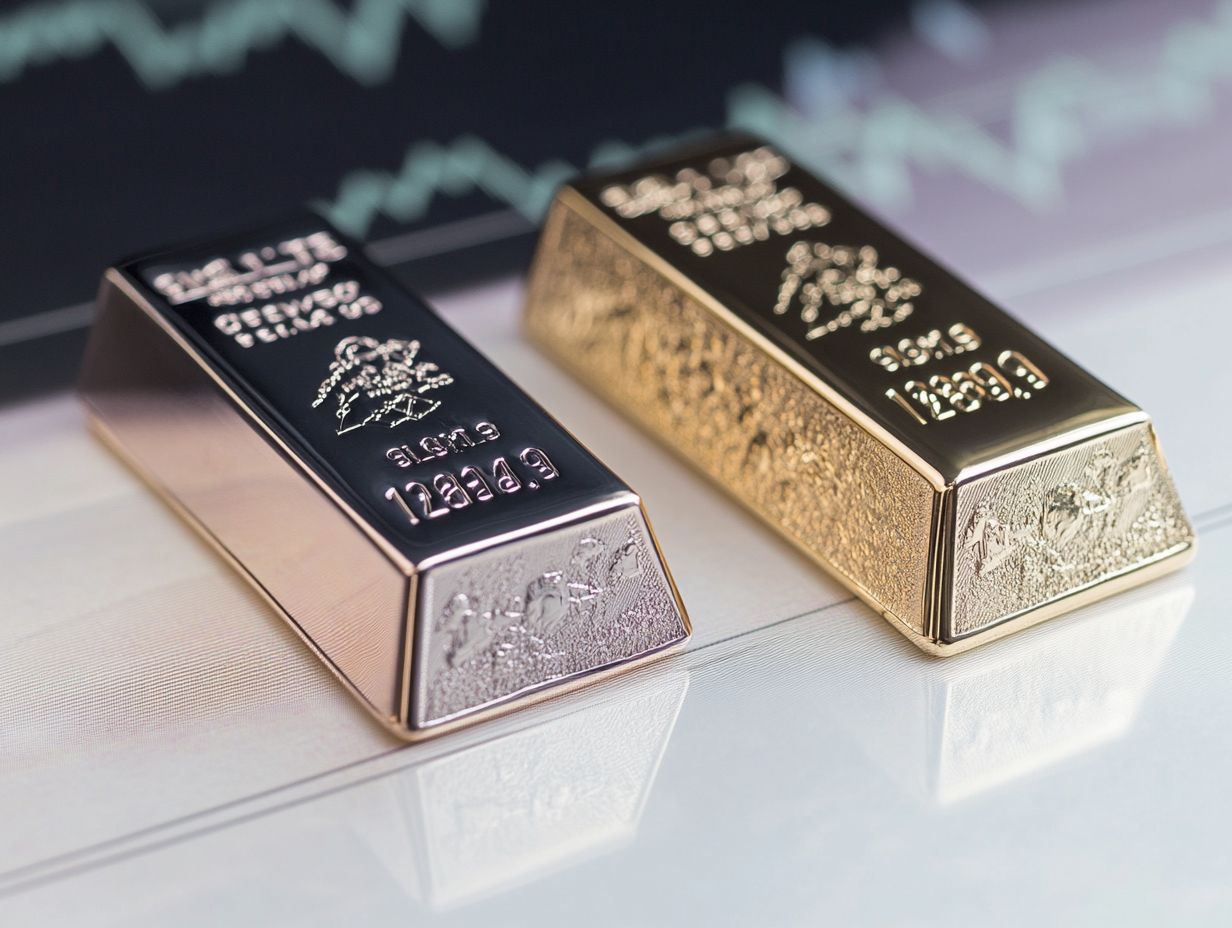
If you’re thinking about investing in platinum and palladium, consider key factors such as market trends, supply deficits, and historical price fluctuations that could impact your returns.
Keep a close eye on the demand-supply dynamics. Disruptions in mining or an uptick in industrial use can significantly shift market behavior. The rarity of these metals also plays a pivotal role, as both are less abundant than gold, making them particularly desirable under certain economic conditions.
Historical price trends showcase how these precious metals can serve as a protection against rising prices and economic uncertainty. Regulatory changes and geopolitical issues can affect availability and market sentiment, influencing your potential investment outcomes.
Pros and Cons
Investing in platinum and palladium presents a unique blend of advantages and challenges. These precious metals can enrich your investment portfolio with their distinct characteristics, but they also come with market dynamics and potential rapid price changes that you need to navigate.
If you re aiming to diversify your assets, platinum and palladium hold intriguing investment potential, largely fueled by their applications in industries like automotive and electronics where demand is steadily growing. However, it s essential for you to remain vigilant about the market risks. Fluctuations in supply and geopolitical factors can lead to unpredictable price movements that could impact your investments.
Both platinum and palladium can act as a hedge against inflation, but their price volatility can pose significant threats to your financial stability. Weighing these benefits against the drawbacks is crucial for anyone contemplating the addition of these metals to their portfolio.
Comparing the Performance of Platinum and Palladium
When you compare the performance of platinum and palladium, you’ll uncover critical insights that can significantly impact your investment strategy. By examining their historical price trends, you can see how unique supply and demand factors influence each metal differently.
Grasping these distinctions is essential for determining which option may better serve you as an investment asset.
Historical Price Trends
Examining historical price trends for platinum and palladium offers you valuable insights into their investment potential. It reveals the fluctuating values shaped by global demand and market dynamics.
Over the years, both metals have experienced dramatic swings, often influenced by shifts within the automotive industry, evolving technological applications, and changing geopolitical landscapes.
For instance, platinum has typically commanded higher prices due to its rarity and essential role in catalytic converters. In contrast, palladium s recent surge in value reflects its heightened demand in hybrid and electric vehicles.
By analyzing these trends, you can gain a clearer understanding of how external factors such as variations in mining output and economic cycles play critical roles in shaping the future trajectories of these precious metals.
Supply and Demand Factors
Supply and demand factors are crucial in shaping the market dynamics of platinum and palladium. They significantly impact their availability and pricing on the global stage.
As global mining operations rise and fall based on political climates, these precious metals experience fluctuations in output levels. Global politics, such as sanctions or trade agreements with major producers like South Africa and Russia, can dramatically reshape supply chains and, consequently, market equilibrium.
The surging demand for catalytic converters in the automotive sector heightens competition for these metals. Both consumers and industrial players are increasingly competing for these limited resources, driving prices upward and influencing your short-term trading strategies and long-term investment decisions!
How to Buy and Store Platinum and Palladium
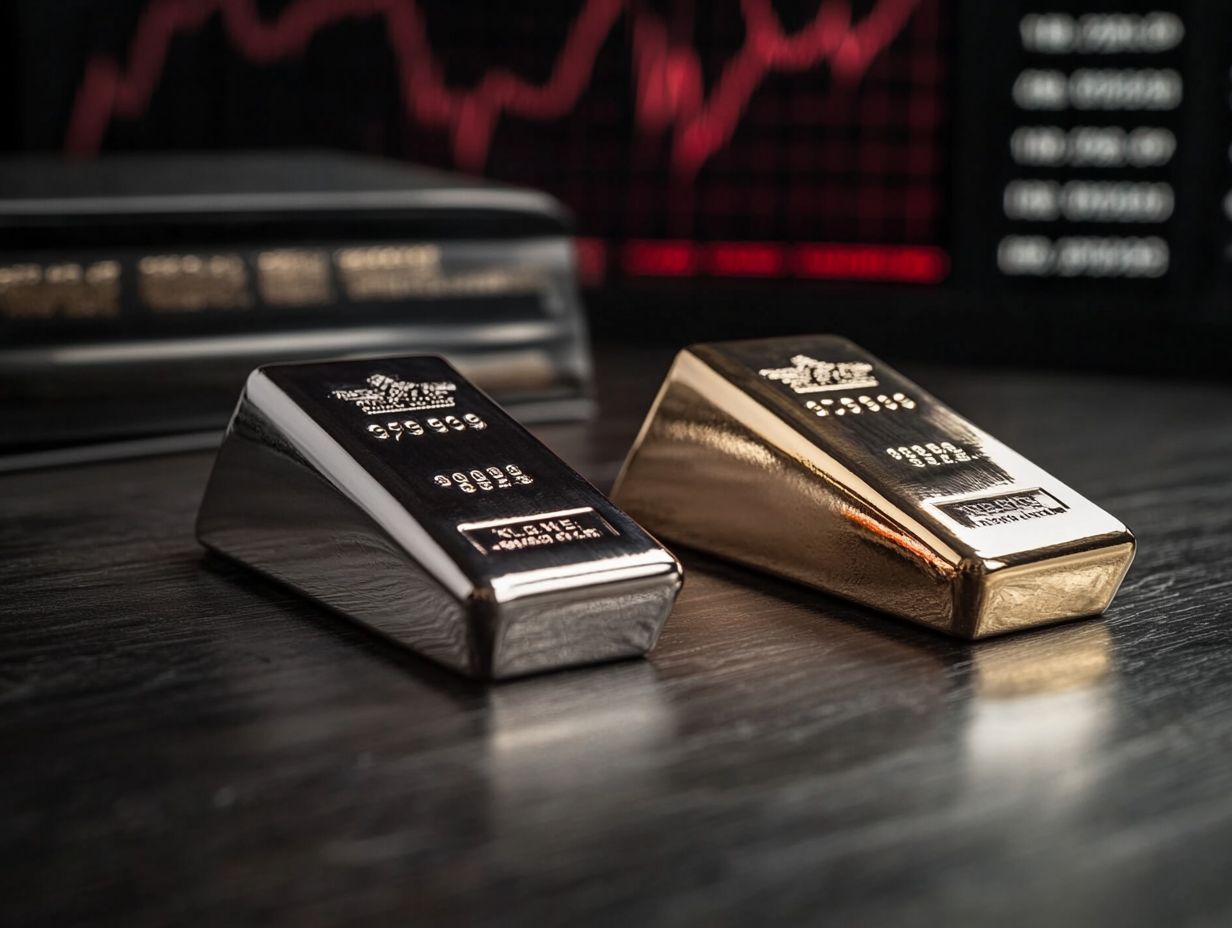
Acquiring and securely storing platinum and palladium is essential for investors looking to enhance their portfolios with these exquisite precious metals. This process requires a keen understanding of the diverse buying options available and the important security considerations that come into play.
Investment Options
- ETFs: A seamless way to gain exposure to these precious metals without the hassle of physical storage.
- Bullion: Provides the comfort of a tangible asset, which many investors find reassuring.
- Jewelry: Visually appealing, but usually carries a higher markup and may not yield the expected return on investment.
By carefully evaluating these options, you can determine which aligns best with your financial goals and risk tolerance.
Storage and Security Considerations
Proper storage and security are paramount for safeguarding your platinum and palladium investments. These precious metals demand specific conditions to retain their value.
Be acutely aware that volatility in the precious metal markets can lead to significant financial consequences if your assets aren t adequately protected. Ideally, these metals should be housed in a secure facility, such as a professional vault or safe deposit box, where climate control and humidity levels are carefully monitored to prevent damage.
Investing in insurance policies specifically designed for precious metals can offer further protection against potential losses. Regular inventory checks, combined with the use of serial numbers, can provide an extra layer of security, ensuring your stored assets are always accounted for.
Frequently Asked Questions
What is the difference between platinum and palladium?
Platinum and palladium are both precious metals, but they have different chemical and physical properties. Platinum is denser and more malleable, while palladium is lighter and more ductile. They also have different uses, with platinum commonly used in jewelry and palladium primarily used in catalytic converters.
Which is a better investment: platinum or palladium?
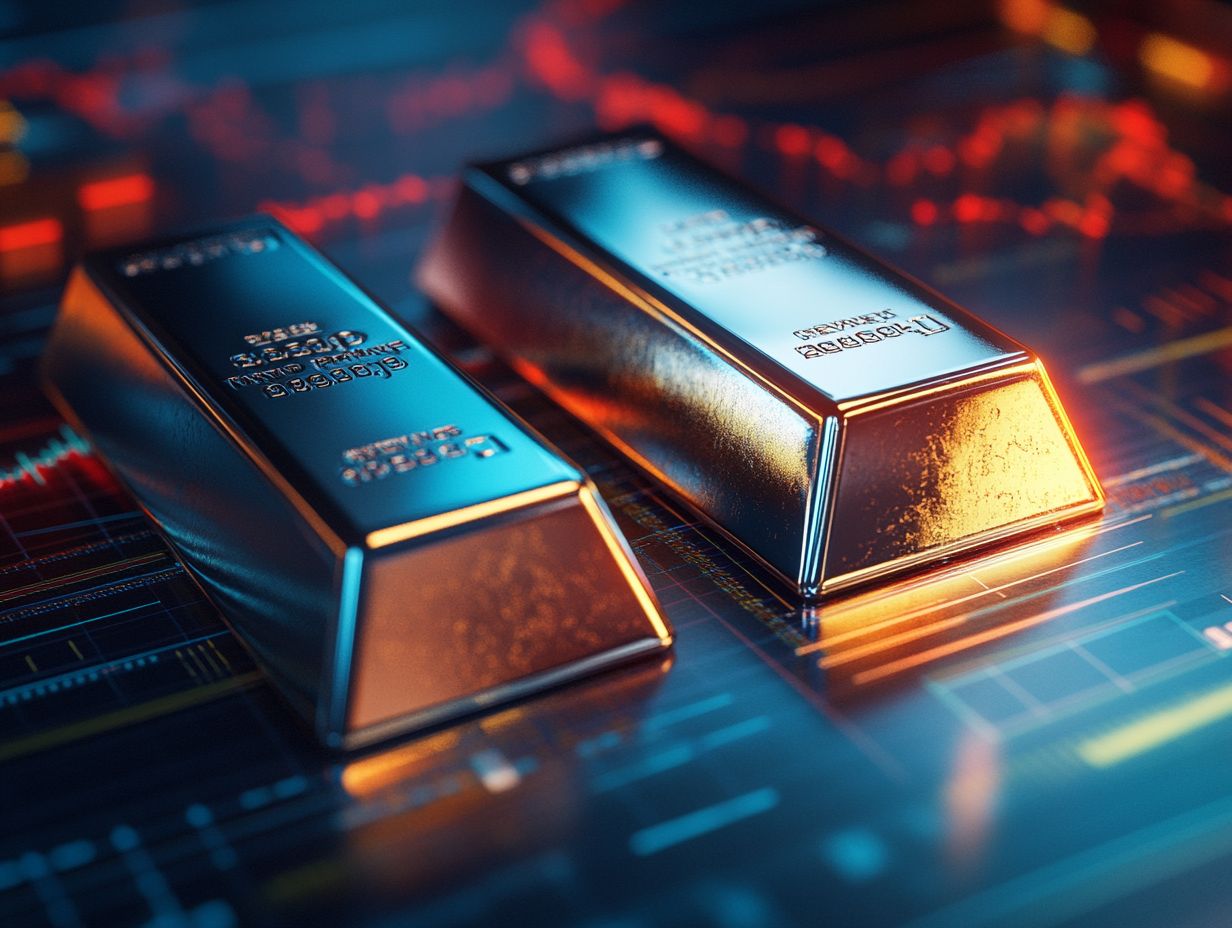
It ultimately depends on your investment goals and risk tolerance. Platinum is generally considered a more stable investment, but palladium has seen a significant increase in demand due to its use in the automotive industry. It’s important to carefully research both metals and consult with a financial advisor before making a decision.
What Factors Affect the Prices of Platinum and Palladium?
The prices of platinum and palladium fluctuate based on supply and demand, economic conditions, and geopolitical events. Keeping an eye on these factors is crucial for understanding market trends.
Is It Possible to Invest in Both Metals?
Absolutely! Investing in both platinum and palladium can diversify your portfolio. This strategy can help reduce risk and enhance potential returns.
What Are the Storage and Maintenance Requirements?
Store platinum and palladium in a secure place, like a bank vault or a safe storage facility. Regular maintenance, including cleaning and polishing, is essential for preserving their value and appearance.
Are There Any Tax Implications for Investing?
Yes, investing in these metals can have tax implications. Don t miss out! Consult a tax professional to understand how this might affect your investment strategy!










